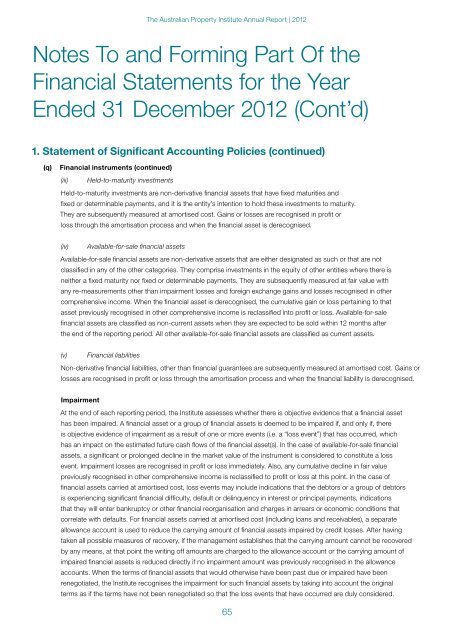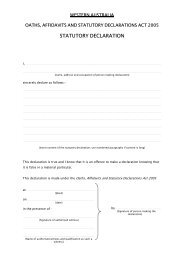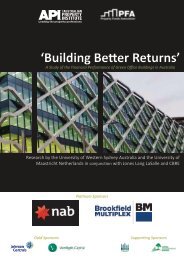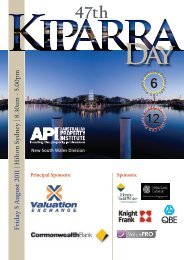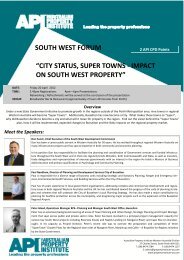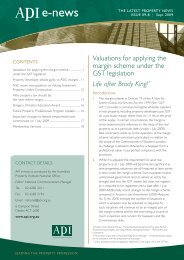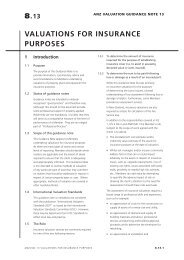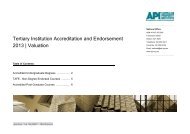Annual Report 2012 - The Australian Property Institute
Annual Report 2012 - The Australian Property Institute
Annual Report 2012 - The Australian Property Institute
Create successful ePaper yourself
Turn your PDF publications into a flip-book with our unique Google optimized e-Paper software.
<strong>The</strong> <strong>Australian</strong> <strong>Property</strong> <strong>Institute</strong> <strong>Annual</strong> <strong>Report</strong> | <strong>2012</strong>Notes To and Forming Part Of theFinancial Statements for the YearEnded 31 December <strong>2012</strong> (Cont’d)1. Statement of Significant Accounting Policies (continued)(q)Financial instruments (continued)(iii) Held-to-maturity investmentsHeld-to-maturity investments are non-derivative financial assets that have fixed maturities andfixed or determinable payments, and it is the entity’s intention to hold these investments to maturity.<strong>The</strong>y are subsequently measured at amortised cost. Gains or losses are recognised in profit orloss through the amortisation process and when the financial asset is derecognised.(iv) Available-for-sale financial assetsAvailable-for-sale financial assets are non-derivative assets that are either designated as such or that are notclassified in any of the other categories. <strong>The</strong>y comprise investments in the equity of other entities where there isneither a fixed maturity nor fixed or determinable payments. <strong>The</strong>y are subsequently measured at fair value withany re-measurements other than impairment losses and foreign exchange gains and losses recognised in othercomprehensive income. When the financial asset is derecognised, the cumulative gain or loss pertaining to thatasset previously recognised in other comprehensive income is reclassified into profit or loss. Available-for-salefinancial assets are classified as non-current assets when they are expected to be sold within 12 months afterthe end of the reporting period. All other available-for-sale financial assets are classified as current assets.(v) Financial liabilitiesNon-derivative financial liabilities, other than financial guarantees are subsequently measured at amortised cost. Gains orlosses are recognised in profit or loss through the amortisation process and when the financial liability is derecognised.ImpairmentAt the end of each reporting period, the <strong>Institute</strong> assesses whether there is objective evidence that a financial assethas been impaired. A financial asset or a group of financial assets is deemed to be impaired if, and only if, thereis objective evidence of impairment as a result of one or more events (i.e. a “loss event”) that has occurred, whichhas an impact on the estimated future cash flows of the financial asset(s). In the case of available-for-sale financialassets, a significant or prolonged decline in the market value of the instrument is considered to constitute a lossevent. Impairment losses are recognised in profit or loss immediately. Also, any cumulative decline in fair valuepreviously recognised in other comprehensive income is reclassified to profit or loss at this point. In the case offinancial assets carried at amortised cost, loss events may include indications that the debtors or a group of debtorsis experiencing significant financial difficulty, default or delinquency in interest or principal payments, indicationsthat they will enter bankruptcy or other financial reorganisation and charges in arrears or economic conditions thatcorrelate with defaults. For financial assets carried at amortised cost (including loans and receivables), a separateallowance account is used to reduce the carrying amount of financial assets impaired by credit losses. After havingtaken all possible measures of recovery, if the management establishes that the carrying amount cannot be recoveredby any means, at that point the writing off amounts are charged to the allowance account or the carrying amount ofimpaired financial assets is reduced directly if no impairment amount was previously recognised in the allowanceaccounts. When the terms of financial assets that would otherwise have been past due or impaired have beenrenegotiated, the <strong>Institute</strong> recognises the impairment for such financial assets by taking into account the originalterms as if the terms have not been renegotiated so that the loss events that have occurred are duly considered.65


